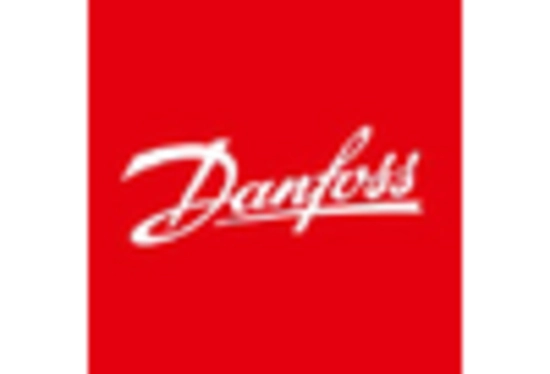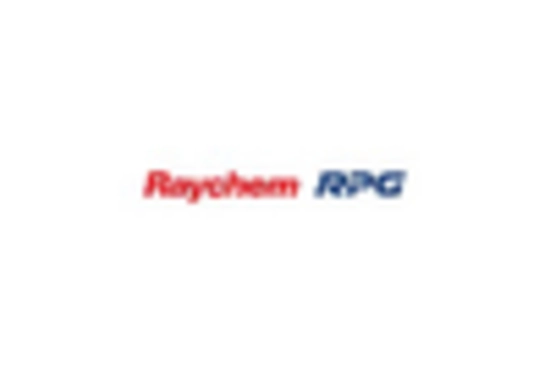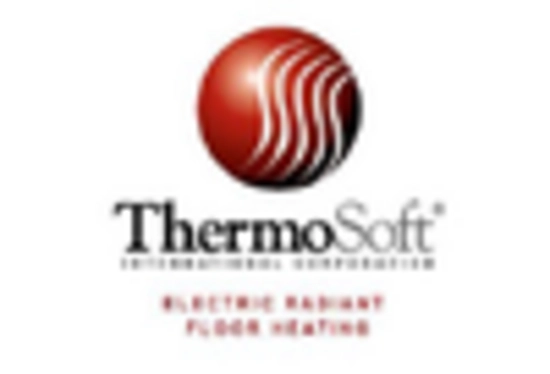Rising Consumer Awareness
The increasing awareness among consumers regarding the benefits of energy-efficient heating solutions is a notable driver for the Residential Electric Underfloor Heating Market. As homeowners seek to reduce energy consumption and lower utility bills, electric underfloor heating systems are gaining traction. These systems are perceived as more efficient compared to traditional heating methods, which often lead to higher energy costs. According to recent data, the adoption of electric underfloor heating has surged by approximately 25% in residential applications over the past few years. This trend indicates a shift in consumer preferences towards modern heating solutions that not only provide comfort but also contribute to energy savings. As awareness continues to grow, it is likely that more consumers will opt for electric underfloor heating, further propelling the market forward.
Technological Advancements
Technological advancements play a crucial role in shaping the Residential Electric Underfloor Heating Market. Innovations in heating technology, such as improved insulation materials and advanced control systems, have enhanced the efficiency and effectiveness of electric underfloor heating solutions. For instance, the integration of smart thermostats allows homeowners to control their heating systems remotely, optimizing energy usage and comfort levels. Furthermore, the development of thin heating mats and cables has made installation easier and more versatile, appealing to a broader range of consumers. Market data suggests that the introduction of these technologies has led to a 30% increase in the installation of electric underfloor heating systems in new residential constructions. As technology continues to evolve, it is anticipated that the market will experience sustained growth driven by these advancements.
Increased Focus on Indoor Comfort
The heightened focus on indoor comfort is emerging as a vital driver for the Residential Electric Underfloor Heating Market. As people spend more time indoors, particularly in colder climates, the demand for effective heating solutions has intensified. Electric underfloor heating systems provide a consistent and comfortable warmth that enhances the overall living experience. This growing emphasis on comfort is reflected in market trends, with a reported increase in consumer preference for underfloor heating systems over traditional radiators. Data suggests that the market for electric underfloor heating has expanded by approximately 20% in regions with colder weather patterns. As the desire for improved indoor comfort continues to rise, it is likely that the adoption of electric underfloor heating will further accelerate, driving market growth.
Regulatory Support for Energy Efficiency
Regulatory support for energy efficiency initiatives is a significant driver for the Residential Electric Underfloor Heating Market. Governments worldwide are implementing policies and incentives aimed at promoting energy-efficient heating solutions. These regulations often encourage homeowners to adopt electric underfloor heating systems as a means to comply with energy efficiency standards. For example, various regions have introduced tax credits and rebates for the installation of energy-efficient heating systems, which can significantly reduce the upfront costs for consumers. This regulatory environment is expected to foster a favorable market landscape, as more homeowners are incentivized to transition to electric underfloor heating. As a result, the market is likely to witness an increase in adoption rates, further solidifying the position of electric underfloor heating in residential settings.
Growing Renovation and Remodeling Activities
The growing trend of home renovation and remodeling is a key driver for the Residential Electric Underfloor Heating Market. As homeowners invest in upgrading their living spaces, there is a rising demand for modern heating solutions that enhance comfort and aesthetics. Electric underfloor heating systems are particularly appealing in renovation projects due to their ability to be installed under various floor types without compromising design. Market analysis indicates that the renovation sector has expanded significantly, with a notable increase in projects incorporating electric underfloor heating. This trend is expected to continue, as homeowners increasingly prioritize comfort and energy efficiency in their renovation plans. Consequently, the market for electric underfloor heating is likely to benefit from this growing interest in home improvement.


















Leave a Comment